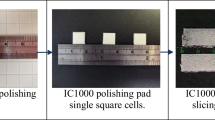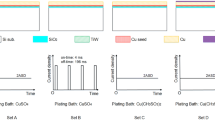Abstract
Technologies in semiconductor industry have been developed into a three-dimensional multilayer wiring for high integration of devices. Chemical mechanical planarization (CMP) process is one of the key technologies for achieving multilayer wiring, which enables global planarization. In addition, highly integrated devices can be realized by increasing the depth of focus in the photolithography process. However, in the inter-layer dielectric (ILD) CMP of the transistor, the uppermost oxide layer has the step due to the arrangement of the devices. The ideal material removal mechanism is to gradually remove materials from the top of the step height which allows for global planarization. However, in the CMP of the patterned wafers, simultaneous polishing of the upper and lower layers occurs when the step height reaches a certain height. This means that the polishing is strongly dependent on the structural characteristics of the pattern. Especially, the difference in the material removal rate depending on the pattern density acts as a constraint in terms of device layout. Therefore, it is essential to develop an accurate prediction model of material removal rate as a function of pattern density, size and arrangement. This study aims to define the mathematical planarization model according to contact mode between a polishing pad and patterned wafer. Considering that the real contact area between the actual polishing pad and the wafer is about 1 %, the mathematical model is derived based on the microscopic deformation of the pad asperities, not the macroscopic deformation of the bulk pad. Finally, we describe the verification between the theoretical material removal rate model and step height reduction and the actual CMP results. The root mean square error of the upper layer material rate, the lower material removal rate, and the step height reduction were 24.59 nm/min, 22.03 nm/min and 22.6 nm, respectively. Compared with the previous studies, the new model of this study improved the error by up to 50.9 %.
Similar content being viewed by others
References
K. A. Reinhardy and W. Kern, Handbook of Silicon Wafer Cleaning Technology, William Andrew, Norwich (2008).
Y. Takeno and K. Okamoto, New market trend in CMP equipment/material for the “More than Moore” era, Proc. ICEP-IAAC (2018).
H. D. Jeong, Monitoring System in CMP Process, RacRim-CMP (2004) 54–65.
R. Casrtellano, CMP Technology: Competition, Products, Markets, the Information Network, Willianburg (1997) 21–25.
D. Boning, B. Lee, C. Oji, D. Ouma, T. Park, T. Smith and T. Tugbawa, Pattern dependent modeling for CMP optimization and control, Proc. MRS (1999).
B. Stine, D. Ouma, R. Divecha, D. Boning and J. Chung, A closed-form analytic model for ILD thickness variation in CMP process, Proc. CMP-MIC (1997).
D. Ouma, D. Boning, J. Chung, G. Shinn, L. Olsen and J. Clark, An integrated characterization and modeling methodology for CMP dielectric planarization, Proc. IEEE-IITC (1998) 67–69.
B. Tang, Characterization and modeling of polysilicon MEMS chemical-mechanical polishing, Master Thesis, Department of Electrical Engineering and Computer Science, Massachusetts Institute of Technology (2004).
H. J. Kim, A study on the interfacial characteristics and its effect on material removal in CMP, Ph.D. Thesis, Department of Mechanical Engineering, Pusan National University (2003).
C. Elmufdi and G. Muldowney, A novel optical technique to measure pad-wafer contact area in chemical mechanical planarization, Proc. MRS, 914 (2006).
B. J. Hooper, G. Byrne and S. Galligan, Pad conditioning in chemical mechanical polishing, Journal of Materials Processing Technology, 123 (2002) 107–113.
N. Suzuki, S. Oshika, H. Misono, Y. Hashimoto and H. Ya-suda, Improvement of material removal efficiency by optimization of anisotropic contact of pad asperities, Proc. ICPT (2017).
F. W. Preston, The theory and design of plate glass polishing machines, Journal of the Society of Glass Technology, 11 (1927) 214–256.
K. L. Johnson, Contact Mechanics, Cambridge University Press (1985) 90–106.
J. J. Vlassak, A model for chemical-mechanical polishing of a material surface based on contact mechanics, Journal of the Mechanics and Physics of Solids, 52 (2004) 847–873.
J. A. Greenwood and J. B. P. Willamson, Contact of nominally flat surfaces, Proc. The Royal Society of London, Series A, Mathematical and Physical Sciences, 295 (1442) (1966) 300–319.
B. Vasilev, R. Rzehak, S. Bott and P. Kücher, Greenwood-Williamson model combining pattern-density and pattern-size effects in CMP, IEEE Transactions on Semiconductor Manufacturing, 24 (2) (2011) 338–347.
Z. Yang, Q. Xu and L. Chen, A chemical mechanical planarization model including global pressure distribution and feature size effects, IEEE Packaging and Manufacturing Technology, 6 (2) (2016) 177–184.
B. Vasilev, S. Bott, R. Rzehak, R. Liske and J. W. Bartha, A method for characterizing the pad surface texture and modeling its impact on the planarization in CMP, Microelectronic Engineering, 104 (2013) 48–57.
S. Babu, Advances in Chemical Mechanical Planarization (CMP), Elsevier (2016) 417–432.
Y. Zhao, D. M. Maietta and L. Chang, An asperity microcontact model incorporating the transition from elastic deformation to fully plastic flow, Journal of Tribology, 122 (2000) 86–93.
S. H. Kim, N. Saka and J. H. Chun, The role of pad topography in chemical-mechanical polishing, IEEE Transactions on Semiconductor Manufacturing, 27 (3) (2014) 431–442.
S. H. Kim, N. Saka and J. H. Chun, The effect of pad-asperity curvature on material removal rate in chemical-mechanical polishing, Proc. CIRP, 14 (2013) 42–47.
SKW Associates, Inc., http://www.testwafer.com/testwafers.htm.
D. S. Lee, H. S. Lee and H. D. Jeong, The effects of a spray slurry nozzle on copper CMP for reduction in slurry consumption, Journal of Mechanical Science and Technology, 29 (12) (2015) 5057–5062.
Acknowledgements
This research was supported by the National Research Foundation of Korea (NRF) grant funded by the Korea government (MSIP) (No. 2016R1A2B4011466).
Author information
Authors and Affiliations
Corresponding author
Additional information
Recommended by Editor Hyung Wook Park
Hyunjin Kim received the M.S. degree in the Department of Mechanical Engineering, Pusan National University. His research interest is mathematical CMP modeling.
Somin Shin is M.S. candidate in the Department of Mechanical Engineering, Pusan National University. Her research interest is CMP simulation.
Dasol Lee is Ph.D. candidate in the Department of Mechanical Engineering, Pusan National University. Her research interest includes chemical mechanical polishing (CMP) of electronic materials and manufacturing.
Haedo Jeong is a Professor in the Department of Mechanical Engineering, Pusan National University. His research fields include chemical mechanical planarization (CMP), grinding, polisher and consumable design and post-CMP cleaning.
Rights and permissions
About this article
Cite this article
Kim, H., Shin, S., Lee, D. et al. Mathematical modeling based on contact mechanism due to elastic and plastic deformation of pad asperities during CMP. J Mech Sci Technol 34, 289–300 (2020). https://doi.org/10.1007/s12206-019-1230-0
Received:
Revised:
Accepted:
Published:
Issue Date:
DOI: https://doi.org/10.1007/s12206-019-1230-0




